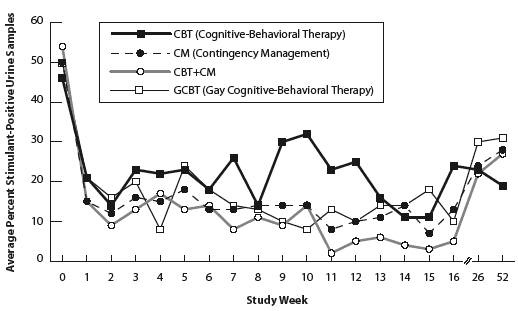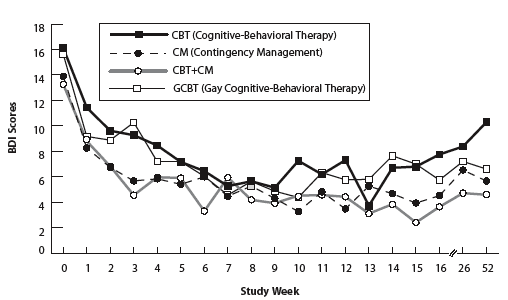Behavioral therapy can help gay and bisexual men (GBM) reduce methamphetamine abuse and risky sexual behaviors and sustain these gains for 1 year, NIDA-funded researchers report. By the end of a 16-week trial of four different behavioral therapies, study participants' stimulant-positive urine samples fell 31 percent, and their number of past-month sexual partners fell more than 50 percent—outcomes that regressed little at the followup visits. Symptoms of depression also improved.
 Benefits of Behavioral Therapy Persist Up to One Year. Although all interventions were effective, participants who received contingency management (CM), cognitive-behavioral therapy (CBT) and CM, or culturally tailored Gay CBT (GCBT) submitted fewer stimulant-positive urine samples during treatment, compared with those in standard CBT.
Benefits of Behavioral Therapy Persist Up to One Year. Although all interventions were effective, participants who received contingency management (CM), cognitive-behavioral therapy (CBT) and CM, or culturally tailored Gay CBT (GCBT) submitted fewer stimulant-positive urine samples during treatment, compared with those in standard CBT.Dr. Steven Shoptaw and colleagues at the University of California, Los Angeles and the Friends Research Institute recruited 263 methamphetamine-addicted GBM throughout Los Angeles County, particularly in Hollywood, where HIV prevalence is especially high. Of these, 162 completed the requirements for entering the treatment phase of the study, which were to attend six assessments and participate in at least two of four group sessions on abstinence skills during a 2-week "baseline period." Men who met the requirements reported less severity and shorter duration of methamphetamine abuse than those who did not, despite having abused methamphetamine for 5 years and having spent $293 on the drug in the past month, on average. Half had engaged in unprotected anal intercourse (UAI) with someone other than their primary partner in the past month, and 84 percent of these men linked the behavior to methamphetamine abuse. Most participants (73 percent) reported symptoms of depression, with about 30 percent describing these as moderate to severe.
The researchers randomly assigned each patient to one of four behavioral therapies: cognitive-behavioral therapy (CBT), contingency management (CM), CBT+CM, or Gay CBT (GCBT). In CBT, participants analyzed situations and emotions linked with relapse, practiced ways to manage craving and thoughts about drug abuse, and discussed healthy behaviors in group sessions. In CM, participants received vouchers redeemable for groceries, transportation, and clothing if they submitted stimulant-negative urine samples. GCBT addressed standard CBT issues—including relapse, craving, and healthy behaviors—using specific examples from gay cultural events and environments. For example, they compared the experience of owning up to a drug problem with the experience of acknowledging sexual orientation by "coming out." All four interventions were offered three times a week for 4 months.
Multiple, Lasting Benefits
Participants reduced methamphetamine abuse and risky sexual behaviors and experienced fewer depression symptoms in the last month of treatment compared with the month before therapy, regardless of the therapeutic approach. Overall, they decreased methamphetamine abuse from 9.6 to 2.4 days a month and reduced the number of past-month sexual partners from 9.8 to 4.3, on average. The percentage who reported unprotected insertive anal intercourse—a risk factor for HIV-infected individuals to transmit the virus to partners—fell from 36.9 percent to 16.7 percent by the end of treatment. Beck Depression Inventory (BDI) scores improved from 14.3 (in the "mild to moderate" range) at baseline to 5.4 ("minimal") in the last week of treatment.
Although all therapies benefited participants, response to the treatments differed. During the treatment period, participants in GCBT and the combined treatments attended more weeks of therapy and submitted fewer stimulant-positive urine samples than those who received standard CBT during treatment. Participants receiving GCBT showed a faster decrease in unprotected receptive anal intercourse— a risk factor for acquiring the virus from a partner—compared with those in standard CBT. Most participants (80 percent) took part in the 1-year followup. Generally, they sustained the lower levels of methamphetamine abuse, risky sexual behaviors, and depression observed at the end of treatment (see "Benefits of Behavioral Therapy Persist Up to One Year").
"It is encouraging that several types of behavioral treatment reduced both drug abuse and risky sexual behaviors among gay and bisexual men at high risk for contracting or transmitting HIV," says Ms. Debra Grossman of NIDA's Division of Neuroscience and Behavioral Research. However, more studies are needed to determine the components of treatment that affect risky sexual behaviors and the link between methamphetamine abuse and such behaviors in other populations, she adds.
 All Four Therapies Reduced Depression Symptoms Participants demonstrated improvement in Beck Depression Inventory scores, which dropped sharply the first week of treatment and leveled off at week 4.
All Four Therapies Reduced Depression Symptoms Participants demonstrated improvement in Beck Depression Inventory scores, which dropped sharply the first week of treatment and leveled off at week 4.Methamphetamine Treatment as HIV Prevention
For about a decade in California, the drug most tightly linked with HIV infection in GBM has been methamphetamine. The drug conveys a sense of heightened sexuality in the short term and is associated with risky sexual behaviors and extremely high rates of HIV infection in those seeking treatment. Sixty percent of the participants in Dr. Shoptaw's study reported HIV-positive status, a prevalence much higher than his group has observed among GBM seeking treatment for cocaine (30 percent), alcohol (15 percent), or heroin (5 percent) abuse.
"The reductions in risky sexual behavior in this study exceeded those observed in HIV prevention trials among GBM. We conclude that treatment for meth abuse fits into a comprehensive HIV prevention strategy," says Dr. Shoptaw. The findings have already made an impact: These data helped policymakers at the California Office of AIDS decide to allocate $3 million for programs that address methamphetamine abuse among GBM.
Methamphetamine and the Blues
The researchers were not surprised by the high percentage of their study participants who reported depression symptoms at the beginning of the study. GBM are three times as likely as heterosexual men to have clinical depression.
Methamphetamine abusers often say they take the drug to kick the blues, but results from the current study suggest that continuing abuse may serve to relieve low moods related to stimulant withdrawal rather than alleviate underlying chronic depression.
When they analyzed the temporal link between methamphetamine abuse and depression, Dr. Shoptaw and his colleagues found that a urine sample indicating abuse of the drug within the past 5 days strongly predicted high BDI scores and abstinence strongly predicted low scores. In contrast, BDI scores did not predict episodes of future methamphetamine abuse, which is what would be expected if the men were abusing the drug to alleviate depression. "Meth abusers probably remember feeling better after taking the drug, but this perception may not match the physiology of long-term stimulant abuse," says Dr. James Peck, a member of the research team who led the analysis of the depression data.
Sources
- Shoptaw, S., et al. Behavioral treatment approaches for methamphetamine dependence and HIV-related sexual risk behaviors among urban gay and bisexual men. Drug and Alcohol Dependence 78(2):125-134, 2005. [Abstract]
- Peck, J.A., et al. Sustained reductions in drug use and depression symptoms from treatment for drug abuse in methamphetamine-dependent gay and bisexual men. Journal of Urban Health 82(1):i100-i108, 2005. [Abstract]
